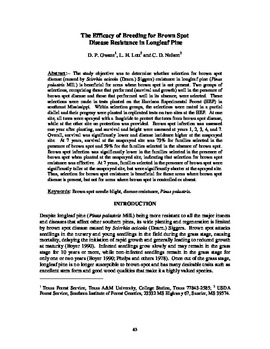| dc.contributor.author | Gwaze, D. P. | |
| dc.contributor.author | Lott, L. H. | |
| dc.contributor.author | Nelson, C. D. | |
| dc.date.accessioned | 2016-04-25T19:35:57Z | |
| dc.date.available | 2016-04-25T19:35:57Z | |
| dc.date.issued | 2003 | |
| dc.identifier | oksd_sf27_p063.pdf | |
| dc.identifier.citation | Gwaze, D. P., Lott, L. H., & Nelson, C. D. (2003). "The Efficacy of Breeding for Brown Spot Disease Resistance in Longleaf Pine." In 27th Southern Forest Tree Improvement Conference, Stillwater, OK | |
| dc.identifier.uri | https://hdl.handle.net/11244/33663 | |
| dc.description.abstract | The study objective was to determine whether selection for brown spot disease (caused by Scirrhia acicola (Dearn.) Siggers) resistance in longleaf pine (Pinus palustris Mill.) is beneficial for areas where brown spot is not present. Two groups of selections, comprising those that performed (survival and growth) well in the presence of brown spot disease and those that performed well in its absence, were selected. These selections were made in tests planted on the Harrison Experimental Forest (HEF) in southeast Mississippi. Within selection groups, the selections were mated in a partial diallel and their progeny were planted in replicated tests on two sites at the HEF. At one site, all trees were sprayed with a fungicide to protect the trees from brown spot disease, while at the other site no protection was provided. Brown spot infection was assessed one year after planting, and survival and height were assessed at years 1, 2, 3, 4, and 7. Overall, survival was significantly lower and disease incidence higher at the unsprayed site. At 7 years, survival at the unsprayed site was 73% for families selected in the presence of brown spot and 59% for the families selected in the absence of brown spot. Brown spot infection was significantly lower in the families selected in the presence of brown spot when planted at the unsprayed site, indicating that selection for brown spot resistance was effective. At 7 years, families selected in the presence of brown spot were significantly taller at the unsprayed site, but were significantly shorter at the sprayed site. Thus, selection for brown spot resistance is beneficial for those areas where brown spot disease is present, but not for areas where brown spot is controlled or absent. | |
| dc.format | application/pdf | |
| dc.language | en_US | |
| dc.relation.ispartofseries | Sponsored publication . . . of the Southern Forest Tree Improvement Committee ; no. 49 | |
| dc.rights | This paper is made available through open access and the auspices of the fair use doctrine for scholarly, educational and research purposes while recognizing the publisher already offers a free online version. The OSU Library�s intent is to offer access and preserve publications involving its faculty contributions. Contact the Digital Resources and Discovery Services at lib-dls@okstate.edu or 405-744-9161 for the permission policy on the use, reproduction or distribution of this material. | |
| dc.source | Proceedings of the 27th Southern Forest Tree Improvement Conference, volume 27, 2003. Editor, Craig R. McKinley. | |
| dc.title | Efficacy of Breeding for Brown Spot Disease Resistance in Longleaf Pine | |
| dc.type | text | |
| osu.filename | oksd_sf27_p063.pdf | |
| dc.type.genre | Conference proceedings | |
| dc.subject.keywords | brown spot needle blight | |
| dc.subject.keywords | disease resistance | |
| dc.subject.keywords | pinus palustris | |
| dc.description.scopeandcontents | Papers and abstracts from the 27th Southern Forest Tree Improvement Conference held at Oklahoma State University in Stillwater, Oklahoma on June 24-27, 2003. | |
